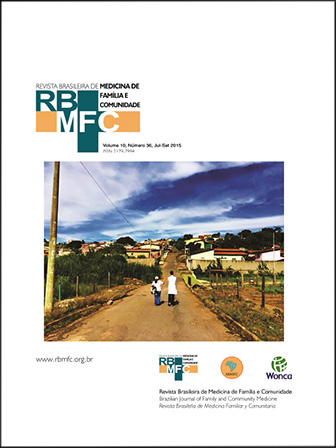Breast and testicular self-examinations in cancer screening: a matter of quaternary prevention?
DOI:
https://doi.org/10.5712/rbmfc10(36)1094Keywords:
Breast Neoplasms, Urologic Neoplasms, Mass Screening, Prevention & Control, Quaternary PreventionAbstract
Health care includes important preventive attitudes that are divided into four categories: primary, secondary, tertiary, and quaternary. Quaternary prevention refers to the avoidance of the implementation of procedures whose benefits are doubtful and damages are unknown or notorious. Counseling for self-examinations in breast and testicular cancer screenings can fall under the purview of quaternary prevention. However, there is a lack of randomized controlled trials that examine the effectiveness and safety of testicular self-examination. Meanwhile, in two large randomized controlled clinical trials, breast self-examination has been proven to cause harm (anxiety and biopsies to detect benign lesions) as a screening method, with no benefit in terms of mortality rates. Healthcare professionals should be aware that the absence of counseling in this context, paradoxically results in the protection of health, especially with reference to breast cancer screening. It is a simple example of how less is more.
Downloads
Metrics
References
World Organization of National Colleges, Academies and Academic Associations of General Practitioners/Family Physicians (WONCA) Europe. The European definition of General Practice/Family Medicine. WOMCA Europe; 2011. p.8-12 [cited 2015 Jul 21] Available from: http://www.woncaeurope.org/sites/default/files/documents/Definition%203rd%20ed%202011%20with%20revised%20wonca%20tree.pdf
Maciosek MV, Coffield AB, Edwards NM, Flottemesch TJ, Goodman MJ, Solberg LI. Priorities among effective clinical preventive services: results of a systematic review and analysis. Am J Prev Med. 2006;31(1):52-61. DOI: http://dx.doi.org/10.1016/j.amepre.2006.03.012
Kopes-Kerr C. Preventive health: time for change. Am Fam Physician. 2010;82(6):610-4. PMID: 20842988
RACGP National Standing Committee. The role of general practice in prevention and health promotion. Melbourne: Royal Australian College of General Practitioners; 2006.
Bentzen N, ed. WONCA dictionary of general/family practice. Copenhagen: Wonca Inter-national Classification Committee; 2003.
Melo M. A prevenção quaternária contra os excessos da medicina. Rev Port Clin Geral 2007;23(3):289-93.
Moynihan R, Doust J, Henry D Preventing overdiagnosis: how to stop harming the healthy. BMJ. 2012;344:e3502. PMID: 22645185 DOI:http://dx.doi.org/10.1136/bmj.e3502
Camacho JG, Moral EG, Gracia LJ. Prevención cuaternaria: es posible (y deseable) una asistencia sanitaria menos dañina. AMF. 2012;8(6):312-7.
Lin K, Sharangpani R. Screening for testicular cancer: an evidence review for the U.S. Pre-ventive Services Task Force. Ann Intern Med. 2010;153(6):396-9. DOI: http://dx.doi.org/10.7326/0003-4819-153-6-201009210-00007
America Cancer Society. What are the key statistics about testicular cancer? [Internet] [cited 2015 Jul 21]. Available from: http://www.cancer.org/cancer/testicularcancer/detailedguide/testicular-cancer-key-statistics
Souza KW, Reis PED, Gomes IP, Carvalho EC. Estratégias de prevenção para câncer do testículo e pénis: revisão integrativa. Rev Esc Enferm USP. 2011;45(1):277-82. DOI: http://dx.doi.org/10.1590/S0080-62342011000100039
Brenner JS, Hergenroeder AC, Kozinetz CA, Kelder SH. Teaching testicular self-examination: education and practices in pediatric residents. Pediatrics. 2003;111(3):e239-44. PMID: 12612278 DOI: http://dx.doi.org/10.1542/peds.111.3.e239
America Cancer Society. What are the key statistics about breast cancer? [cited 2015 Jul 21]. Available from: http://www.cancer.org/cancer/breastcancer/detailedguide/breast-cancer-key-statistics
Thornton H, Pillarisetti RR. ‘Breast awareness’ and ‘breast self-examination’ are not the same. What do these terms mean? Why are they confused? What can we do? Eur J Cancer. 2008;44(15):2118-21.
Santos JA. Breast self-examination on breast cancer screening: evidence increases as un-certainty fades away. Acta Obstet Ginecol Port. 2013;7(2):113-7.
Nelson HD, Tyne K, Naik A, Bougatsos C, Chan BK, Humphrey L; U.S. Preventive Ser-vices Task Force. Screening for breast cancer: an update for the U.S. Preventive Services Task Force. Ann Intern Med. 2009;151(10):727-37. DOI: http://dx.doi.org/10.7326/0003-4819-151-10-200911170-00009
Thomas DB, Gao DL, Ray RM, Wang WW, Allison CJ, Chen FL, et al. Randomized trial of breast self-examination in Shanghai: final results. J Natl Cancer Inst. 2002;94(19):1445-57. DOI: http://dx.doi.org/10.1093/jnci/94.19.1445
Semiglazov VF, Manikhas AG, Moiseenko VM, Protsenko SA, Kharikova RS, Seleznev IK, et al. Results of a prospective randomized investigation [Russia (St.Petersburg)/WHO] to evaluate the significance of self-examination for the early detection of breast cancer. Vopr Onkol. 2003;49(4):434-41. PMID: 14569932
Kösters JP, Gøtzsche PC. Regular self-examination or clinical examination for early de-tection of breast cancer. Cochrane Database Syst Rev. 2003;(2):CD003373. PMID: 12804462
Brett J, Austoker J, Ong G. Do women who undergo further investigation for breast screening suffer adverse psychological consequences? A multi-centre follow-up study com-paring different breast screening result groups five months after their last breast screening appointment. J Public Health Med. 1998;20(4):396-403. DOI: http://dx.doi.org/10.1093/oxfordjournals.pubmed.a024793
MacFarlane ME, Sony SD. Women, breast lump discovery, and associated stress. Health Care Women Int. 1992;13(1): 23-32. PMID: 1556029 DOI:http://dx.doi.org/10.1080/07399339209515975
Downloads
Published
How to Cite
Issue
Section
License
By submitting a manuscript to the RBMFC, authors retain ownership of the copyright in the article, and authorize RBMFC to publish that manuscript under the Creative Commons Attribution 4.0 license and identify itself as the vehicle of its original publication.















